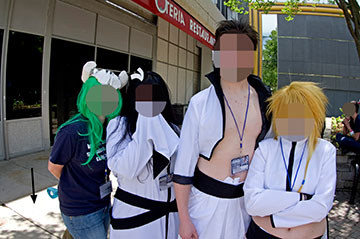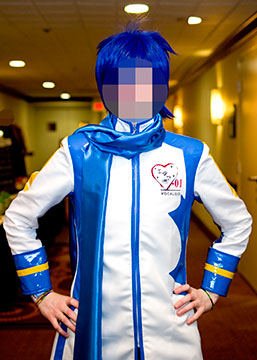Harsh light can make a nicely framed image one that just does not feel like a quality image. Let’s say you are standing outside in a partly shady area or out in the open. Your subject can have harsh shadows being cast from their costume or body parts, causing issues to the overall exposure. You will have extremes in light where the sun’s rays cast on surfaces. It might be on your subject or other objects around them, but that can be fixed sometimes in post-processing. Although, it is best if you can avoid recording harsh light in the first place.

Let’s say you have a cosplayer standing under a tree in the summer months. The tree provides nice shade and helps you form a smoothly exposed image, but there are probably a few gaps through the leaves. If one of those gaps just happens to be casting light on your subject’s body (especially skin), that will most likely blow that section of the image resulting in bright white botches. Not to mention the light around the tree is a lot stronger than the light on your subject, resulting in a blown background.

To get around that, your simplest option would be to find a spot where that won’t be the case. Otherwise, you can use a strobe flash device to provide additional light to the scene, called “fill light,” that will increase the exposure of your subject and even out any extreme sun-ray light that might be cast on or around the subject. You have quite a few technical options when providing strobe based fill light. If you have a flash with or without a diffuser, using standard settings will most likely be sufficient in dealing with the issue since the camera and flash will make strobe the primary source of light in the scene. Flash light is generally pretty harsh looking, so I would suggest always using some type of add-on to smooth out the light by making it more omni-directional.
Second curtain sync: One situation would be at night time where you want the background to be well-lit and in the same level of exposure compared to your subject in the foreground. This mode allows you to shoot your burst of light at the end of the imaging cycle allowing you to use a long exposure time. The long exposure time means your camera will have time to expose the background before using the flash’s light to expose the foreground (subject). Most add-on flash units have this these days. A camera’s shutter consists of a first curtain and second curtain, which slide horizontally across the sensor to form an exposure. The first curtain starts exposing the sensor to light and the second follows it. The shorter the exposure, the faster these curtains will move across the sensor. In extremely fast exposures like 1/8000th of a second, the two curtains are moving across the sensor at the same time, only allowing a sliver of the sensor to record light at a time. When using an add-on flash, you will be limited to how fast your shutter speed can work, usually that is approximately 1/250th of a second or slower in DSLR cameras. The limitation comes because to use a burst of light, the shutter needs to be completely open, allowing the whole frame to receive that additional light. In turn, that means we can vary the exposure time to let in more or less available light before firing off the strobe flash. In addition to changing the shutter speed, you can change the flash’s power level manually to increase or decrease foreground brightness relative to the background.
High Speed Sync (HSS): Allows you to get past the physical and technical limitations of the system you are using. Most systems have a hard limit of 1/160th to 1/250th shutter speed where the flash can normally be used. This is due to how the shutter mechanism works (basically the imaging sensor needs to be fully exposed when the flash burst happens). HSS allows the flash to get around the hard limit by sending out quick pulses of light, so the camera can use faster shutter speeds. A situation where you might find this useful is in extremes of lighting. Say you are near a building, but it is noon and the sun is shining in the background. You want to have a nice blurred background (needing large aperture) in the photo. HSS will allow you to increase your shutter speed and in turn increase the size of your lens aperture opening. That way you will get your foreground and background in the same exposure, but still have nice blurred backgrounds thanks to that large aperture. HSS is usually only on powerful and expensive flash units.
- Overview
- Who is this for?
- What is convention photography?
- My experience and experiences
- Why be a part of this?
- Practice, practice, practice!
- Networking
- Fun
- Photography terms primer.
- Equipment
- It is important or not depending on your ideals
- A basic setup.
- Decide how you want to make it work.
- Framing and composition
- Full body shots.
- Portrait style.
- Skewed angles.
- Face in detail.
- Plane of focus.
- Rule of thirds and golden ratio
- Available light photography.
- Strobe photography.
- Removing harsh light.
- Flash brackets.
- Bokeh and blur maximization.
- Histogram reading and image review.
- Post processing.
- Various schools of thought.
- Available software on your OS of choice.
- Ideas on how to improve your processing.
- Business cards.
- Social networking.
- Website
- The process from start to finish.
- My equipment.
- Ask the person first.
- Interrupting people.
- Constrained areas.
- Physical activity.
- Summary
